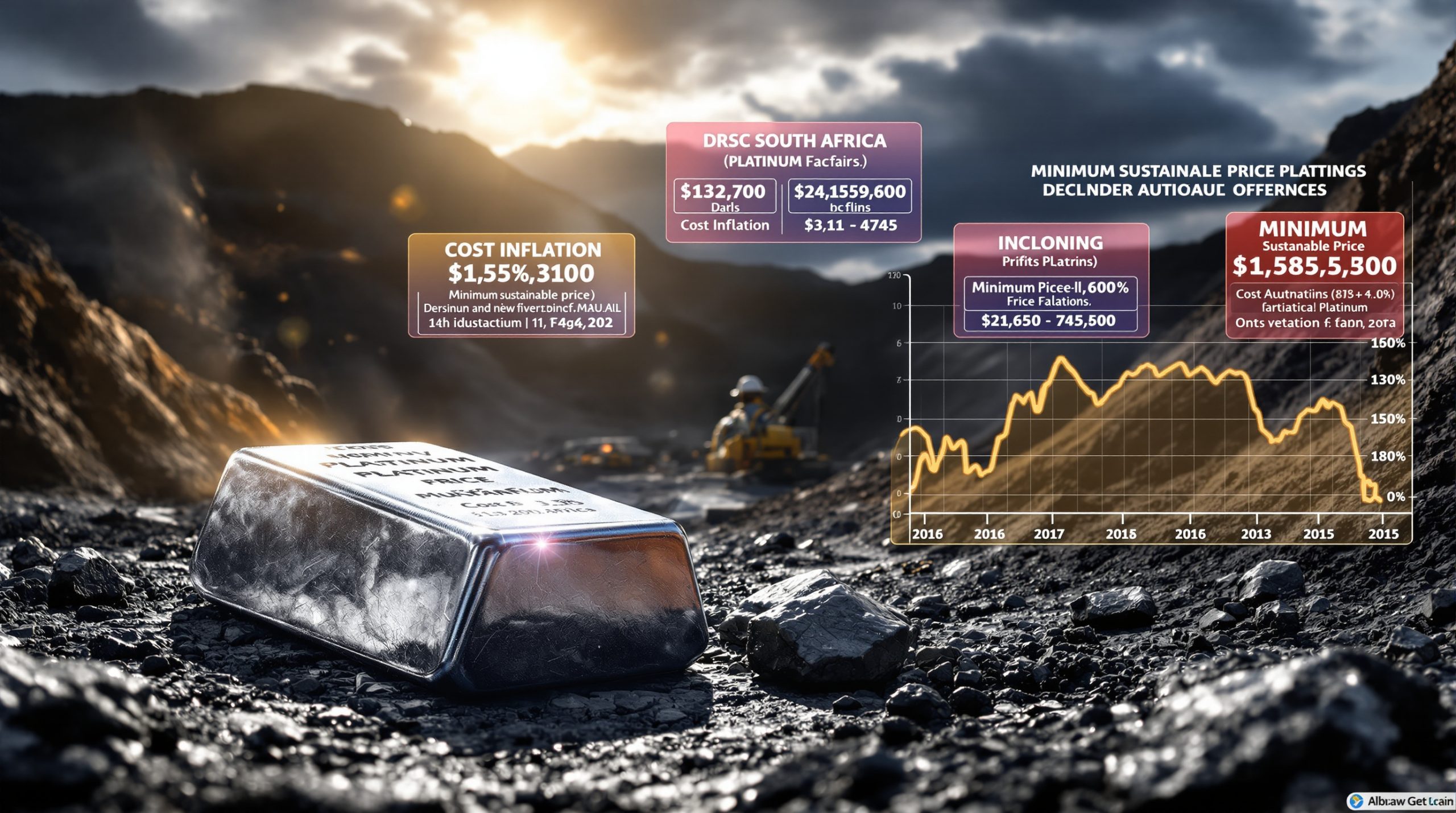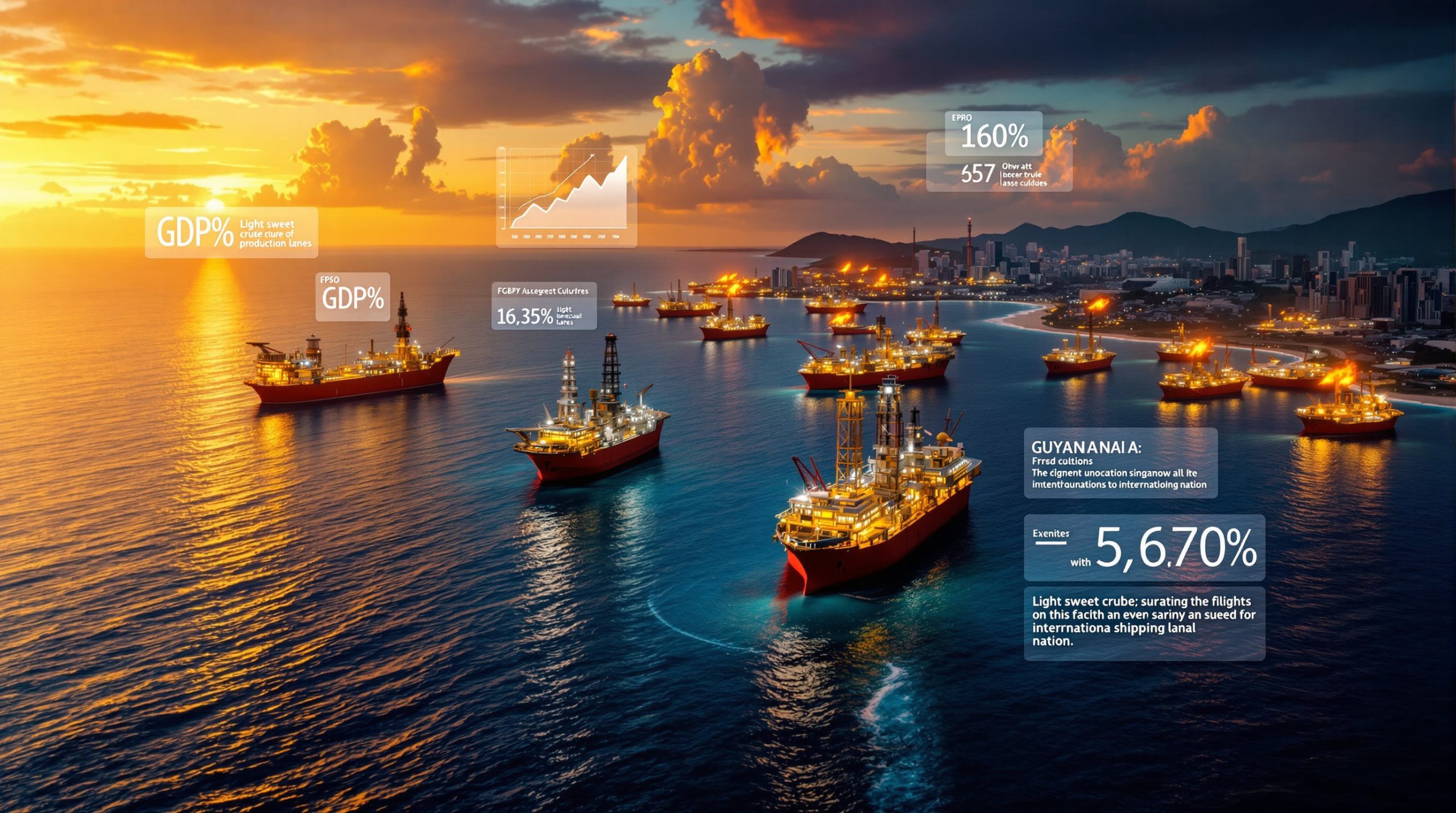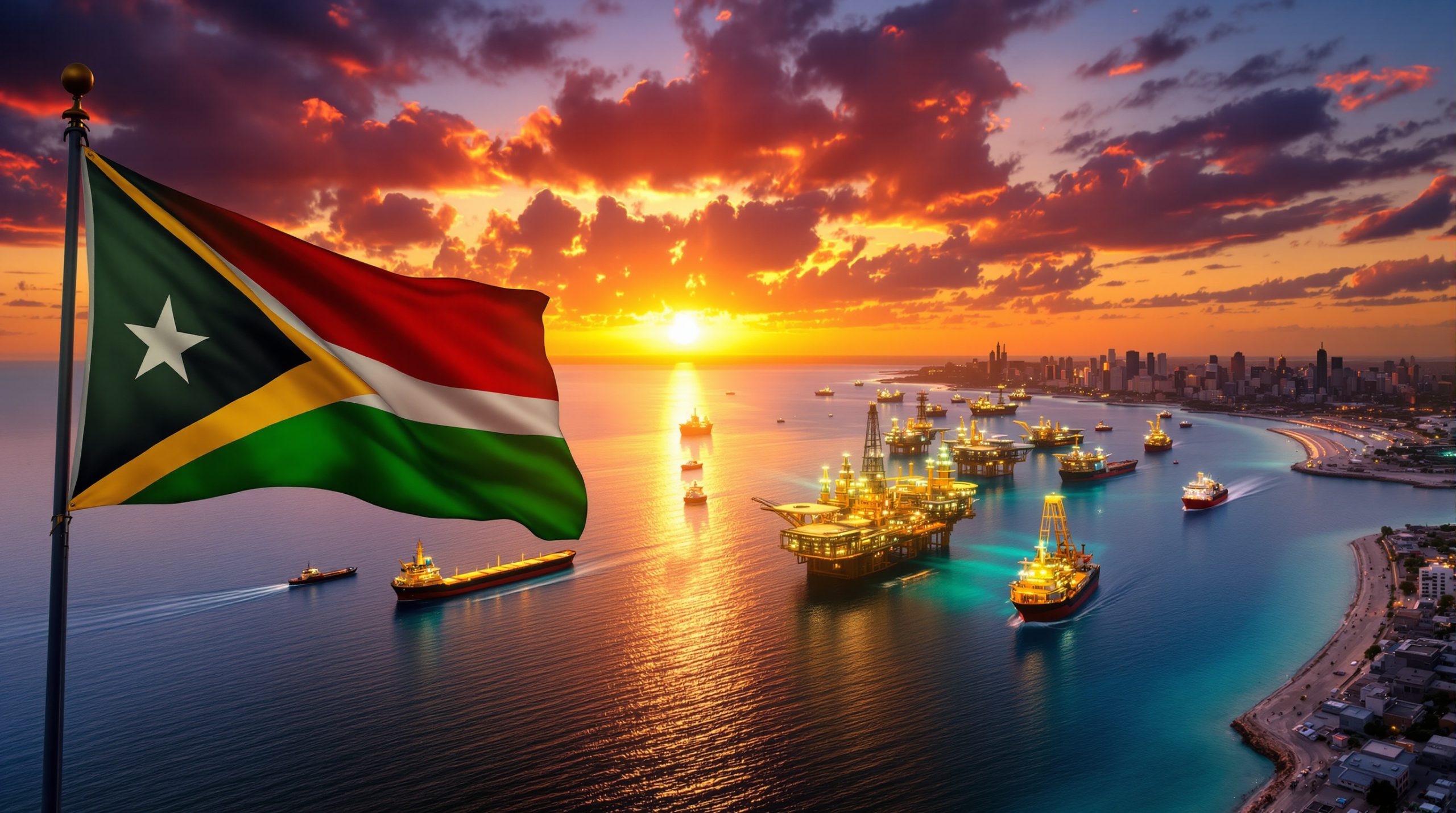How Has Oil Transformed Guyana's Economy?
Guyana has undergone a remarkable economic transformation since major oil discoveries began in 2015. What was once one of the Western Hemisphere's poorest nations has emerged as a global energy powerhouse with unprecedented growth statistics.
The International Monetary Fund reported Guyana's real GDP growth at 57.8% in 2022 and projected continued double-digit growth through 2024, making it one of the world's fastest-growing economies. This meteoric rise represents one of the most dramatic economic turnarounds in modern history.
Oil production reached approximately 645,000 barrels per day in 2024 according to the U.S. Energy Information Administration, with the Liza Phase 1 and Phase 2 projects fully operational in the Stabroek Block. Production is expected to increase substantially as additional developments come online.
The offshore Stabroek Block, operated by ExxonMobil and partners, has proven to be a world-class asset with estimated recoverable resources exceeding 11 billion barrels of oil equivalent. This massive resource base has fundamentally altered Guyana's economic trajectory.
Prior to oil discovery, Guyana's economy relied primarily on agriculture, mining, and forestry. Sugar, rice, bauxite, and gold were the traditional pillars of an economy that struggled with limited growth. The contrast with today's oil-driven economy couldn't be more striking.
The transformation has catapulted Guyana's GDP per capita from among the lowest in South America to projected levels that will soon surpass many of its regional neighbors. This rapid wealth creation has created both unprecedented opportunities and significant challenges.
What's at Stake in Guyana's 2025 Election?
The upcoming general election has become a referendum on how Guyana should manage its newfound petroleum wealth. Two competing visions have emerged in what is shaping up to be the most consequential election in the country's history.
According to Guyana's Constitution, general elections must be held within five years of the last election. The most recent election was held in March 2020, with the People's Progressive Party/Civic (PPP/C) currently holding power under President Irfaan Ali.
Continuity vs. Change: The Central Campaign Divide
The Ruling Party Approach (PPP/C):
- Maintain existing oil contracts to ensure investor confidence
- Focus on infrastructure development using oil revenues
- Emphasize gradual economic diversification
- Highlight stability and predictability for international partners
The Opposition Platform:
- Renegotiate existing contracts for higher government take
- Redirect more oil revenue toward immediate social programs
- Implement stronger local content requirements
- Address concerns about transparency and wealth distribution
This fundamental policy division has transformed the election into a pivotal moment for Guyana's development trajectory, with implications extending far beyond typical electoral politics.
The election will determine not just who governs Guyana but also establish the framework for how the country's vast oil wealth will be managed for generations to come. Political analysts note that this election represents a historic crossroads for the small South American nation.
Regional voting patterns will likely play a significant role, with traditional ethnic divisions potentially being reshaped by debates over oil price movements. Urban centers and rural communities may have differing priorities regarding immediate benefits versus long-term investments.
How Are Oil Revenues Currently Managed?
Guyana established a sovereign wealth fund in 2019, known as the Natural Resource Fund (NRF), to manage its petroleum revenues. As of 2024, the NRF had accumulated over US$2 billion according to government reports.
The current framework includes a formula-based approach with annual withdrawal limits tied to non-oil GDP. Parliamentary approval is required for withdrawals above certain thresholds, creating a legislative check on executive spending power.
| Revenue Management Component | Current Implementation |
|---|---|
| Sovereign Wealth Fund | Natural Resource Fund established 2019 |
| Withdrawal Rules | Formula-based with parliamentary oversight |
| Investment Strategy | Conservative approach with international management |
| Transparency Measures | Quarterly reports with limited public disclosure |
| Local Content Requirements | Graduated targets for Guyanese participation |
When compared to international best practices, Guyana's sovereign wealth fund structure shares some similarities with Norway's Government Pension Fund Global, widely considered the gold standard for resource revenue management. However, transparency advocates have called for stronger public reporting requirements and more detailed disclosure of investment decisions.
Fund management is conducted through international asset managers with expertise in sovereign wealth fund administration, though critics argue that more local capacity building is needed to ensure Guyanese institutions can eventually take greater control of the process.
What Economic Challenges Does Guyana's Oil Boom Create?
Despite the unprecedented economic growth, Guyana faces significant challenges that the next administration must address to avoid the pitfalls that have plagued other resource-rich developing nations.
Economic Distortions and Risks
Dutch Disease Concerns: The Bank of Guyana has reported real exchange rate appreciation concerns in its 2024 monetary policy statements. This appreciation threatens traditional export sectors like agriculture and mining by making their products less competitive internationally.
Inflation Pressures: According to the Guyana Bureau of Statistics, inflation rates have fluctuated significantly since oil production began, with housing costs in Georgetown showing notable increases. This has created affordability challenges for many residents.
Absorptive Capacity Limitations: Economic researchers have identified significant constraints in Guyana's public sector capacity, limiting the effective deployment of sudden revenue increases. The government has struggled to efficiently execute the rapidly expanded capital budget.
Infrastructure Bottlenecks: Existing transportation, energy, and communication networks cannot support rapid growth. Georgetown faces severe traffic congestion, while airport capacity limitations constrain tourism and business travel potential.
Social and Governance Challenges
Wealth Distribution Inequities: Despite overall economic growth, significant portions of the population have yet to feel direct benefits from the oil boom. Rural communities and interior regions report limited improvements in living standards.
Regional Development Imbalances: Benefits tend to concentrate in coastal areas, particularly Georgetown, while interior regions see more limited improvements. This geographical disparity risks exacerbating existing regional tensions.
Institutional Capacity Gaps: Government agencies lack sufficient technical expertise to effectively regulate the complex oil sector. Recruitment and retention of qualified personnel remains difficult when competing with private sector salaries.
Corruption Vulnerabilities: The sudden influx of resource wealth creates new opportunities for misappropriation. Transparency International has highlighted the need for stronger accountability mechanisms as oil revenues grow.
These challenges highlight the complexity of managing a resource boom and underscore why the election outcome matters so significantly for Guyana's future.
How Might Election Results Impact Foreign Investment?
The investment community is closely monitoring Guyana's election, as policy shifts could significantly impact the billions already committed to offshore developments. ExxonMobil and partners have committed over US$10 billion to Guyana developments through 2027.
The current project pipeline includes Payara (sanctioned for 2024 startup), Yellowtail (targeting 2025), and Uaru (under evaluation), representing a massive capital investment that depends on stable fiscal and regulatory conditions.
Investment Risk Scenarios
| Election Outcome | Potential Impact on Investment |
|---|---|
| PPP/C Victory | Continued stability for existing projects; potential for accelerated new licensing |
| Opposition Victory | Possible contract review period; uncertainty for projects in planning stages |
| Contested Result | Temporary investment pause; delay in approval processes |
| Coalition Government | Compromise positions on contract terms; slower decision-making |
Production Sharing Agreements (PSAs) provide the legal framework protecting investor interests, including cost recovery mechanisms and profit sharing formulas. Any changes to these agreements would face significant legal hurdles and potential international arbitration.
Energy industry analysts note that while contract renegotiation is theoretically possible, the practical reality is that dramatic changes would likely damage Guyana's reputation with international investors and potentially delay future development phases.
Investment decisions are particularly sensitive to fiscal stability, with companies requiring predictable terms before committing billions to long-term projects. Even rhetoric about contract reviews can impact investment opportunities and scale.
What Regional Implications Does Guyana's Oil Boom Have?
Guyana's emergence as a major oil producer reshapes regional dynamics in several important ways, creating both new opportunities and potential flashpoints in South American and Caribbean relations.
Shifting Regional Power Dynamics
Venezuela Relations: The Essequibo region dispute covers approximately 159,500 square kilometers, representing about two-thirds of Guyana's current territory. Regional security analysts have noted increased Venezuelan military rhetoric regarding the Essequibo region coinciding with major oil discoveries.
Caribbean Energy Politics: Guyana potentially becomes a regional energy supplier, altering traditional dependencies on Venezuela and Trinidad & Tobago. CARICOM nations are exploring new energy cooperation frameworks centered on Guyanese resources.
Brazil's Strategic Interest: Growing economic integration with northern Brazil through infrastructure projects is creating new trade corridors. Brazilian companies are increasingly active in Guyana's service sector and logistics infrastructure.
US Strategic Engagement: The United States has significantly increased its diplomatic and security presence as Guyana's strategic importance grows. This includes expanded military training programs and diplomatic initiatives.
The election outcome will influence how Guyana positions itself within these complex regional relationships, particularly regarding border security and economic integration initiatives. A new administration might shift priorities in terms of regional alliances and security cooperation.
Cooperation agreements with Brazil on road connectivity and port access have accelerated in recent years, providing Guyana with important regional ties beyond its traditional Caribbean relationships. Meanwhile, shifts in Venezuela oil policy continue to affect regional dynamics.
How Do Environmental Concerns Factor into the Election?
Despite the economic benefits, Guyana's oil boom raises significant environmental questions that have become election issues with both domestic and international dimensions.
Environmental Policy Debates
Carbon Emissions vs. Development Rights: Guyana's per capita CO2 emissions remain below global average despite oil production, according to the Global Carbon Atlas. However, the country faces difficult questions about its development pathway in a carbon-constrained world.
Coastal Protection Concerns: Guyana's low-lying coastal areas, where most of the population lives, face climate vulnerability while the country produces fossil fuels. This creates a policy tension between economic development and climate resilience.
Regulatory Framework Adequacy: Environmental Impact Assessments are required for all offshore operations, but questions remain about enforcement capacity and emergency response capabilities in case of spills or other incidents.
Conservation Commitments: Guyana maintains approximately 85% forest cover, among the highest globally according to the Food and Agriculture Organization. The country's REDD+ program and international climate commitments now exist in tension with its new status as an oil producer.
Both major political factions have articulated different approaches to these environmental challenges, with varying emphasis on international climate commitments versus development priorities. The ruling party emphasizes the right to development and gradual transition, while opposition groups often advocate for stronger environmental protections.
The country's carbon sequestration tech initiatives and forest conservation programs represent potential models for balancing resource extraction with environmental stewardship, though implementation challenges remain significant.
What Can Guyana Learn from Other Oil-Producing Nations?
Historical examples offer important lessons for Guyana as it navigates its resource boom, with both cautionary tales and success stories to consider.
Comparative Resource Management Models
| Country | Management Approach | Outcomes | Lessons for Guyana |
|---|---|---|---|
| Norway | Strong sovereign fund with strict withdrawal rules | Long-term prosperity; economic stability | Institutional discipline is essential |
| Trinidad & Tobago | Regional energy hub with diversification efforts | Mixed results with boom-bust cycles | Diversification requires early action |
| Nigeria | Weak institutional oversight; political distribution | Widespread corruption; limited development | Strong governance must precede spending |
| Botswana (diamonds) | Conservative revenue management; education focus | Sustained development; political stability | Resource wealth can support human capital |
Norway's Government Pension Fund Global holds over US$1.4 trillion, following strict fiscal rules established in the 1990s. This represents the gold standard for resource wealth management, though critics note that Norway's pre-existing institutional strength made implementation easier than in developing contexts.
Trinidad & Tobago's experience as a Caribbean oil and gas producer offers particularly relevant lessons. Its Heritage and Stabilisation Fund established in 2007 has shown mixed results during oil price volatility periods, highlighting the challenges of maintaining fiscal discipline during downturns.
Ghana's more recent oil development experience demonstrates the difficulties of managing expectations and avoiding debt accumulation based on projected future revenues. Guyana has the advantage of learning from Ghana's challenges with institutional capacity building.
How Might Guyana's Oil Wealth Be Better Distributed?
A central election issue concerns how petroleum revenues should benefit the broader population, with competing visions for immediate versus long-term benefits.
Competing Distribution Proposals
Current Government Approach:
- Infrastructure-led development strategy focusing on roads, bridges, and airports
- Gradual expansion of social services through traditional government programs
- Education and healthcare investments targeting long-term human capital development
- Tax reductions and subsidies on essential goods to provide immediate relief
Opposition Alternatives:
- Direct cash transfers to citizens similar to Alaska's Permanent Fund Dividend
- Accelerated social housing programs to address urban housing shortages
- Immediate expansion of welfare systems targeting the most vulnerable
- Greater emphasis on rural development to counter urban-rural disparities
These competing visions reflect fundamental differences in development philosophy and timing, with significant implications for how quickly average Guyanese citizens might feel the benefits of the oil boom.
Direct cash transfer programs have shown success in some contexts but require strong identification systems and financial infrastructure. Guyana's banking penetration and digital payment systems would need significant upgrades to implement such programs effectively.
Infrastructure investments offer long-term economic benefits but can take years to complete and may not provide immediate relief to struggling households. Furthermore, the ongoing debate about Alaska drilling policy provides additional perspectives on how resource-rich regions balance development with conservation.
What Does Guyana's Future Look Like Beyond Oil?
While petroleum dominates current economic discussions, both major political groups acknowledge the need for long-term planning beyond the oil era. Non-oil sectors still represent approximately 35% of GDP according to the Bank of Guyana.
Economic Diversification Strategies
Agriculture Modernization: Guyana has significant unused arable land suitable for expansion according to FAO assessments. Leveraging oil revenues to transform traditional agricultural sectors through mechanization, improved varieties, and market access could create sustainable jobs.
Tourism Development: The country's pristine rainforests, biodiversity, and unique cultural heritage offer substantial tourism potential. Investing in sustainable tourism infrastructure targeting Guyana's interior could develop an industry that outlasts oil production.
Knowledge Economy: Building educational capacity for service sector growth represents a critical long-term investment. Digital infrastructure and educational initiatives could position Guyana as a regional services hub.
Manufacturing Opportunities: Developing value-added processing for natural resources beyond simple extraction could create industrial jobs. The country's traditional sectors in bauxite, gold, and timber offer opportunities for downstream manufacturing.
The election will significantly influence which of these diversification pathways receives priority funding and policy support in the crucial early years of Guyana's resource boom. Early investments in these sectors could help Guyana avoid the "resource curse" that has plagued many oil-dependent economies.
Strategic investments in technical and vocational training will be essential to ensure Guyanese workers can participate in these emerging sectors. Current skills gaps represent a significant constraint on diversification efforts.
Guyana's economic future beyond oil will depend on how effectively today's windfall is transformed into sustainable productive capacity across multiple sectors. The decisions made during this critical period, including how to handle Guyana's oil boom reelection priorities, will shape the country's development for generations to come.
Looking to Profit from the Next Major Mineral Discovery?
Stay ahead of the market with Discovery Alert's proprietary Discovery IQ model, which delivers real-time notifications on significant ASX mineral discoveries, instantly transforming complex data into actionable investment opportunities. Explore how historic discoveries have generated substantial returns by visiting Discovery Alert's dedicated discoveries page and begin your 30-day free trial today.




